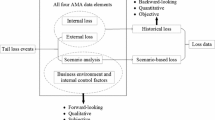Abstract
Graphical information has been widely used in businesses and organizations to display, report and analyze financial information. If the graphical information is inadequately manipulated and employed like the distorted graphs, it may well mislead peoples’ judgment and hence lead their company/organization into a disaster. The study of Mather et al. (Accounting and Business Research 35(2), 147-159, 2005) shows that the graphical distortion of bar chart can be measured by using the relative graph discrepancy index (RGD). The purpose of this research is to find out what level of measurement distortion will mislead users by conducting an experimental study. Research results show that financial graphs tend to mislead users when they are distorted by over ±5 % of the RGD. This threshold should be employed as a means for auditing the related graph distortions.








Similar content being viewed by others
References
Arunachalam, V., Pei, B. K. W., & Steinbart, P. J. (2002). Impression management with graphs: Effects on choices. Journal of Information Systems, 16(2), 183–202.
Beattie, V. A., & Jones, M. J. (1992). The use and abuse of graphs in annual reports: Theoretical framework and empirical study. Accounting and Business Research, 22(88), 291–303.
Beattie, V. A., & Jones, M. J. (1997). A comparative study of the use of financial graphs in the corporate annual reports of major US and UK companies. Journal of International Financial Management and Accounting, 8(I), 33–68.
Beattie, V. A., & Jones, M. J. (1999). Australian financial graphs: an empirical study. Abacus, 35(1), 46–76.
Beattie, V. A., & Jones, M. J. (2001). A six-country comparison of the use of graphs in annual reports. International Journal of Accounting, 36(2), 195–222.
Beattie, V. A., & Jones, M. J. (2002). Measurement distortion of graphs in corporate reports: an experimental study. Accounting and Accountability Journal, 15(4), 546–564.
Chatterjee, B., Tooley, S., Fatseas, V., & Brown, A. (2011). An analysis of the qualitative characteristics of management commentary reporting by New Zealand companies. Australasian Accounting Business and Finance Journal, 5(4), 43–64.
Cleveland, W. S., & McGill, R. (1987). Graphical perception: the visual decoding of quantitative information on graphical displays of data. Journal of the Royal Statistical Society, 150(3), 192–229.
Dishaw, M. T., & Strong, D. M. (1999). Extending the technology acceptance model with task-technology fit constructs. Information & Management, 36(1), 125–137.
Frownfelter, C., & Fulkerson, C. (1998). Linking the incidence and quality of graphics in annual reports to corporate performance: an international comparison. Advances in Accounting Information Systems, 6, 129–151.
Godfrey, J., Mather, P., & Ramsay, A. (2003). Earnings and impression management in financial reports: the case of CEO changes. Abacus, 39(1), 95–123.
Huang, A. H. (2003). Effects of multimedia on document browsing and navigation: an exploratory empirical investigation. Information & Management, 41(2), 189–198.
Huang, S. Y., Chung, Y. H., & Cheng, W. W. (2008). The effects between numerical tabulations and graphs of financial information on the judgment of investors. Review of Business Information System, 12(4), 41–56.
Ianniello, G. (2009). The use of graphs in annual reports of major Italian companies. International Journal of Accounting, Auditing and Performance Evaluation, 5(4), 442–462.
Jones, M. J. (2011). The nature, use and impression management of graphs in social and environmental accounting. Accounting Forum, 35(2), 75–89.
Lee, Y. W., Strong, D. M., Kahn, B. K., & Wang, R. Y. (2002). AIMQ: a methodology for information quality assessment. Information & Management, 40(2), 133–146.
Leivian, G. M. (1980). How to communicate financial data more efficiently. Management Accounting, 62, 31–34.
Mather, P., Ramsay, A., & Steen, A. (2000). The use and representational faithfulness of graphs in IPO prospectuses. Accounting, Auditing and Accountability Journal, 13(1), 65–83.
Mather, D., Mather, P., & Ramsay, A. (2005). An investigation into the measurement of graph distortion in financial reports. Accounting and Business Research, 35(2), 147–159.
Muino, F. M., & Trombetta, M. (2009). Does graph disclosure bias reduce the cost of equity capital? Accounting and Business Research, 39(2), 83–102.
O’Connor, N. G., & Martinsons, M. (2006). Management of information systems: insights from accounting research. Information & Management, 43(8), 1014–1024.
Raschke, R. L., & Steinbart, P. J. (2008). Journal of Information Systems, 22(2), 23–52.
Simcox, W. A. (1984). A method for pragmatic communication in graphic displays. Human Factors, 26(4), 483–7.
Steinbart, P. J. (1989). The auditors’ responsibility for the accuracy of graphs in annual reports: some evidence of the need for additional guidance. Accounting Horizons, 3(3), 60–70.
Tufte, E. R. (1983). The visual display of quantitative information. Cheshire (p. 57). CT: Graphics Press.
Wainer, H. (1992). Understanding graphs and tables. Educational Researcher, 21(1), 14–23.
Zahedi, F. M., & Song, J. (2009). Do web sites change customers’ beliefs? a study of prior-posterior beliefs in e-commerce. Information & Management, 46(2), 125–137.
Author information
Authors and Affiliations
Corresponding author
Rights and permissions
About this article
Cite this article
Huang, S.Y., Wu, TH., Chiu, AA. et al. Measurements of mislead threshold of company graph distortion. Inf Syst Front 17, 1111–1132 (2015). https://doi.org/10.1007/s10796-014-9486-5
Published:
Issue Date:
DOI: https://doi.org/10.1007/s10796-014-9486-5




